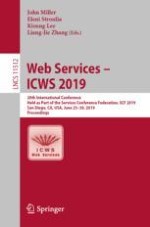2019 | Buch
Web Services – ICWS 2019
26th International Conference, Held as Part of the Services Conference Federation, SCF 2019, San Diego, CA, USA, June 25–30, 2019, Proceedings
herausgegeben von: Prof. John Miller, Eleni Stroulia, Prof. Kisung Lee, Liang-Jie Zhang
Verlag: Springer International Publishing
Buchreihe : Lecture Notes in Computer Science
